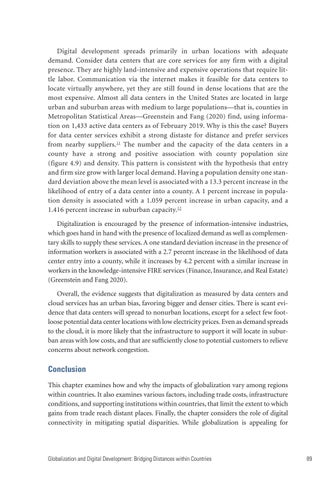Digital development spreads primarily in urban locations with adequate demand. Consider data centers that are core services for any firm with a digital presence. They are highly land-intensive and expensive operations that require little labor. Communication via the internet makes it feasible for data centers to locate virtually anywhere, yet they are still found in dense locations that are the most expensive. Almost all data centers in the United States are located in large urban and suburban areas with medium to large populations—that is, counties in Metropolitan Statistical Areas—Greenstein and Fang (2020) find, using information on 1,433 active data centers as of February 2019. Why is this the case? Buyers for data center services exhibit a strong distaste for distance and prefer services from nearby suppliers.11 The number and the capacity of the data centers in a county have a strong and positive association with county population size (figure 4.9) and density. This pattern is consistent with the hypothesis that entry and firm size grow with larger local demand. Having a population density one standard deviation above the mean level is associated with a 13.3 percent increase in the likelihood of entry of a data center into a county. A 1 percent increase in population density is associated with a 1.059 percent increase in urban capacity, and a 1.416 percent increase in suburban capacity.12 Digitalization is encouraged by the presence of information-intensive industries, which goes hand in hand with the presence of localized demand as well as complementary skills to supply these services. A one standard deviation increase in the presence of information workers is associated with a 2.7 percent increase in the likelihood of data center entry into a county, while it increases by 4.2 percent with a similar increase in workers in the knowledge-intensive FIRE services (Finance, Insurance, and Real Estate) (Greenstein and Fang 2020). Overall, the evidence suggests that digitalization as measured by data centers and cloud services has an urban bias, favoring bigger and denser cities. There is scant evidence that data centers will spread to nonurban locations, except for a select few footloose potential data center locations with low electricity prices. Even as demand spreads to the cloud, it is more likely that the infrastructure to support it will locate in suburban areas with low costs, and that are sufficiently close to potential customers to relieve concerns about network congestion.
Conclusion This chapter examines how and why the impacts of globalization vary among regions within countries. It also examines various factors, including trade costs, infrastructure conditions, and supporting institutions within countries, that limit the extent to which gains from trade reach distant places. Finally, the chapter considers the role of digital connectivity in mitigating spatial disparities. While globalization is appealing for
Globalization and Digital Development: Bridging Distances within Countries
89

